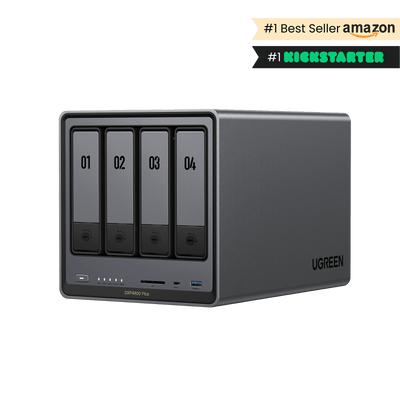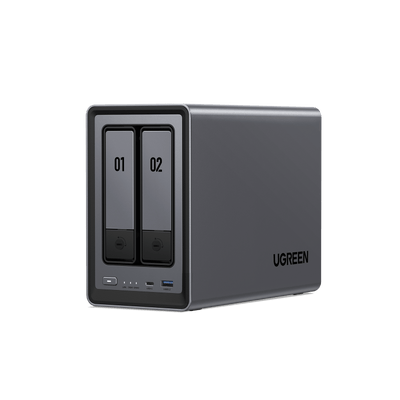How to Use a Mix of SSDs and HDDs in Your NAS
We've compared SSDs and HDDs, noting the trade-offs between speed, capacity, and noise. So what's the solution? A hybrid NAS configuration that delivers the best of both worlds.

Key Takeaways:
- A hybrid NAS setup combines SSDs for speed and HDDs for large, affordable storage—offering the best of both performance and capacity.
- Separate storage pools should be created for SSDs and HDDs to prevent slower drives from limiting overall speed.
- SSD caching can boost performance by using SSDs to store frequently accessed data, reducing reliance on slower HDDs.
- Assign SSD pools to high-performance tasks (VMs, databases, web servers) and HDD pools to capacity-heavy workloads (media, backups, file sharing).
- Always verify drive and NAS compatibility, update firmware, and consult the manufacturer’s Hardware Compatibility List (HCL) before setup.
Configuring Your NAS with Mixed SSDs and HDDs
The fundamental principle of a hybrid NAS configuration is to isolate SSDs and HDDs into separate storage pools. A storage pool is a group of drives managed as a single logical unit. Mixing drive types within a single pool would force the entire array to operate at the speed of the slowest drive, negating the performance benefits of the SSDs. Modern NAS operating systems, such as those from UGREEN NAS UGOS, typically prevent this by design.

Here are the implementation steps:
- Install the Drives: Physically install your SSDs and HDDs into the available NAS bays.
- Create an SSD Storage Pool: Using your NAS interface, create a storage pool exclusively with your SSDs. Select a RAID level appropriate for your needs, such as RAID 1 (mirroring) for redundancy or RAID 0 (striping) for maximum performance. This pool should be reserved for high-speed tasks.
- Create an HDD Storage Pool: Repeat the process for your HDDs, creating a second, separate pool. For this pool, RAID levels like RAID 5 or RAID 6 are often preferred to maximize capacity and fault tolerance, making it ideal for bulk storage.
- Allocate Volumes and Assign Roles: On each storage pool, create distinct volumes (similar to disk partitions) and assign them specific roles. For example, SSD volumes can host applications and databases, while HDD volumes can be used for archives and media libraries.
Leveraging SSD Caching
NAS storage offer a powerful feature known as SSD caching. This technique uses one or more SSDs to accelerate the performance of a larger HDD-based storage pool.
The NAS stores frequently accessed data (a “cache”) on the SSDs, reducing the need to retrieve it from the slower HDDs. In your NAS settings, you can enable caching and assign your SSDs to function as a read-only cache (for faster data retrieval) or a read-write cache (for accelerating both reads and writes).
This is most effective for workloads with repetitive data access patterns, such as file servers or video editing projects.
{{UGPRODUCT}}
Practical Tips for Optimization
To maximize the efficiency of your hybrid setup, consider the following best practices:
- Assign performance-sensitive applications (virtual machines, databases) to the SSD pool. Use the HDD pool for archival data, backups, and large media files that do not require instant access.
- Utilize your NAS’s built-in monitoring tools to track performance and identify potential bottlenecks. Adjust workload distribution as needed.
- Begin with SSDs for your most critical tasks and expand with cost-effective HDDs as your bulk storage requirements grow.
Optimal Use Cases for Hybrid NAS Setups
Here is where different workloads should live in a hybrid setup:
SSD-Driven Workloads (Where Speed is Paramount):
- Virtual Machines (VMs): Hosting VMs on SSDs significantly reduces boot times and improves the responsiveness of multitasking operations.
- Databases: SSDs accelerate query processing, making them essential for responsive database performance in development or small business environments.
- Web Servers: By reducing page load times, SSDs enhance the user experience for websites hosted on a NAS.
HDD-Driven Workloads (Where Capacity is the Priority):
- Media Libraries: HDDs provide vast, cost-effective capacity for storing large collections of movies, music, and photos where streaming performance is sufficient.
- Backups and Archives: The reliability and low cost per gigabyte of HDDs make them the ideal choice for storing long-term archives and system backups.
- Large File Sharing: For sharing large files across a network, HDDs offer the bulk storage capacity needed to handle the load without a significant investment.
The key to a successful hybrid setup is strategic allocation. By assigning the right task to the right storage tier, you create a system that is both fast where it matters and spacious where it counts.
Addressing Compatibility Concerns
Before building a hybrid setup, verify that your NAS model and chosen drives are compatible.
- Verify NAS Model Specifications: Consult your NAS manual or product page to confirm its support for both SATA SSDs and HDDs, as well as NVMe SSDs, which may require specific slots.
- Ensure Firmware is Current: An outdated firmware version may lack support for newer drive models. A simple update can often resolve compatibility issues.
Consider these drive compatibility factors:
- Capacity Matching in RAID: Within a single RAID pool, drives should generally have matching capacities. Using separate pools for SSDs and HDDs effectively bypasses this constraint.
- Performance Isolation: Keeping drive types in separate pools is crucial. This allows each pool to operate at its native speed without being hindered by slower drives.
- Physical Form Factor: Most HDDs are 3.5-inch, while SSDs are typically 2.5-inch. Confirm whether your NAS bays require mounting brackets for the smaller drives.
Manufacturers typically provide an official Hardware Compatibility List (HCL) on their websites. Consulting this list is a critical step to prevent purchasing incompatible drives.
Conclusion
Mixing SSDs and HDDs in your NAS is a strategic approach to optimize performance, capacity, and cost. By isolating workloads, leveraging features like SSD caching, and ensuring hardware compatibility, you can build a highly efficient system tailored to your specific needs. Start with a configuration that meets your current demands and scale your storage as your data grows.




